Karate Etiquette 101: The Unwritten Rules Every Student Should Know
November 20th, 2025

Walking into a karate dojo for the first time can feel exciting, intimidating, and strangely formal all at once. There is bowing, lining up in order, rules you do not quite understand yet, and a pace that seems to move before you fully process what is happening. What most beginners do not realize is that this structure is not meant to confuse you. It is the foundation of karate itself. Etiquette shapes how students train, how they treat each other, and how they carry themselves outside the dojo. Once you understand the unspoken expectations, everything about training feels more natural and a whole lot more enjoyable.
Bowing The Universal Sign of Respect

Bowing is usually the first part of karate etiquette that beginners notice, and it often feels a little formal until you understand the purpose behind it. In most dojos, bowing happens when you enter the training area, when class begins, when class ends, and anytime you work with a partner. It is a small gesture, but it is a reminder to slow down, clear your head, and treat the space and the people around you with respect. Nothing about it is meant to feel ceremonial or intimidating. It is simply a way to acknowledge that everyone in the room is there to learn and help each other improve.
Most new students think bowing is only for instructors, but it is just as important between training partners. When two students bow before practicing a technique or before sparring, they are agreeing to train safely, stay focused, and look out for each other. It creates a moment of mutual understanding that makes the entire class run more smoothly. Even experienced martial artists bow to beginners, because etiquette is about mindset, not rank.
As you spend more time in the dojo, bowing stops feeling like a formality and becomes something that centers you. It marks transitions in the class and helps you shift from your regular daily life into training mode. Whether you are stepping onto the mat after a long day or preparing to work with someone new, that small act of respect sets the tone for positive and productive practice.
Showing Up Early and Prepared

One of the most appreciated habits in any dojo is arriving a little early and being ready to train when class begins. It might seem like a small detail, but it makes a noticeable difference in the way the entire session flows. Students who show up a few minutes ahead of time can stretch, warm up, tie their belts properly, and settle into the right mindset before the instructor starts class. This creates a smoother transition into training and shows respect for everyone's time, especially the students who worked hard to earn their higher ranks.
Being prepared also means bringing what you need and leaving distractions at the door. Phones stay outside the training area, water bottles are filled ahead of time, and uniforms are adjusted before class begins. When you are lined up and ready without rushing, you help create an environment where everyone can focus. Even beginners who are not yet familiar with the routine find that showing up early helps them learn faster and feel more confident during drills and combinations.
Over time, students discover that this habit becomes part of their discipline. The preparation before class almost feels like its own ritual. It signals that it is time to shut out the noise of the day and engage fully with the training ahead. Small choices like this build consistency, and consistency is one of the most important qualities in martial arts.
Keeping Quiet and Staying Focused
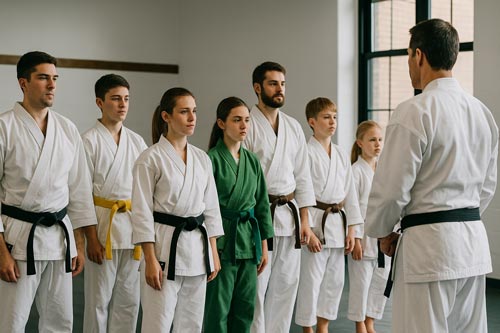
Karate classes move quickly, and most drills build on instructions that were just demonstrated a moment earlier. This is why staying quiet and paying attention is such an important part of dojo etiquette. When students talk during class, even for a few seconds, they often miss small details that can completely change the way a technique works. It also distracts the people around them who are trying to learn. In many dojos, you will notice that students rarely speak unless they are asking a direct question or responding to the instructor. This creates an environment where everyone can concentrate and absorb what is being taught.
Focus is equally important when working with a partner. If your attention drifts during a drill, your reactions become slow and you might apply a technique incorrectly. Staying mentally present shows respect to the person training with you because it tells them you are committed to working safely and giving your best effort. Even beginners can feel the difference when both partners are focused. Movements become smoother, timing improves, and the drill feels much more productive.
Over time, students come to appreciate the quiet moments between combinations or kata repetitions. Those small breaks allow you to reset your breath, think about what you just practiced, and prepare for the next technique. This rhythm is part of what makes karate training so engaging. The balance of intense effort and focused stillness helps you stay grounded and fully involved in each part of the class.
Hygiene and Personal Cleanliness
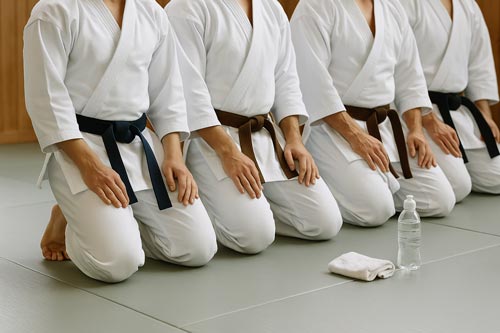
Good hygiene is one of the most important but least talked about parts of karate etiquette. Training involves close contact, shared equipment, and a lot of movement, so maintaining cleanliness is not just polite. It is essential for creating a comfortable and safe environment for everyone. Students are expected to arrive with a clean uniform, trimmed nails, and fresh hands and feet. This helps prevent accidental scratches, cuts, or uncomfortable training moments during partner drills. Even something small like long fingernails can cause injuries when practicing blocks or joint locks, so most dojos make nail trimming a regular part of their expectations.
Personal cleanliness also helps preserve the dojo itself. Mats absorb sweat quickly, and equipment wears down faster when it is used by students who are not taking care of their hygiene. Keeping yourself clean reduces the amount of bacteria on the mats and helps limit the spread of minor illnesses. Most instructors encourage students to stay home if they are feeling sick, and this is not viewed as a lack of dedication. It is considered an act of respect toward the people you train with.
Another part of dojo hygiene is keeping your equipment organized. Shoes are always left outside the training area, and water bottles or bags are placed neatly along the wall. When students keep their belongings tidy, it prevents tripping hazards and keeps the dojo looking professional. These habits may seem minor at first, but they contribute to an atmosphere where everyone can focus and feel comfortable during class.
Why Your Gi Is Part of Karate Etiquette
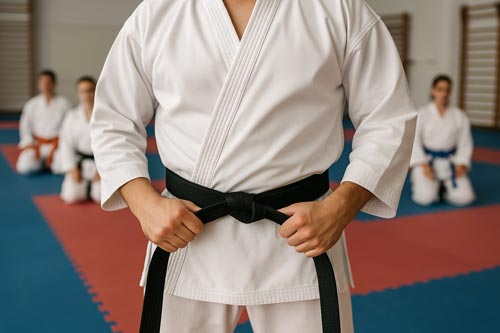
A clean and well-fitting gi is one of the clearest signs that a student respects both the dojo and the practice of karate. In many martial arts, uniforms are treated almost like an extension of the student. The gi does not have to be brand new or expensive, but it should always be clean, dry, and neatly tied. When you show up with a uniform that is cared for, it tells your instructor and training partners that you are serious about being there. It also helps create a unified look during class, which is one of the reasons karate feels so structured and disciplined.
Different dojos have slightly different rules about uniforms, but most follow the same general standards. Your sleeves and pants should be long enough for proper movement, your belt should be tied securely, and your gi should not drag on the floor. These details are not about appearance alone. They help prevent tripping, slipping, and accidental injuries during fast drills or partner work. A well-fitted gi also makes it easier for instructors to see your form and correct your technique.
The uniform also plays a role in dojo culture. Students learn how to fold their gi properly, how to tie their belt correctly, and how to keep their gear in good condition. These habits teach discipline and attention to detail, which carry over into other parts of training. When new students see older students taking care of their uniforms, it sets a quiet example of how to approach the art of karate with respect. For anyone who is starting their journey and needs a reliable, high-quality gi, our selection of karate uniforms offers options for beginners, advanced students, and everything in between.
Respecting Rank and Authority

Karate is built on a clear structure of rank, and understanding how to show respect within that structure is a major part of dojo etiquette. Belts are not just colors. They represent time, effort, and the willingness to push through challenges. When students line up at the start of class, they usually do so by rank. Higher belts stand toward the front, and lower belts line up behind them. This is not about status or favoritism. It allows newer students to follow the lead of those with more experience, especially during warm ups or kata sequences.
Respecting rank also means recognizing the role of the instructor. Whether your instructor is called Sensei, Sifu, or simply Coach, they guide the pace of the class. Students typically wait for the instructor's signal before beginning a technique, switching partners, or moving to another part of the dojo. This structure helps keep everyone safe and organized, especially during sparring sessions or drills that require quick transitions.
Students also learn how to interact respectfully with higher belts. This might include giving them space during certain drills, listening when they offer guidance, or following their example during moments of etiquette. Most senior students are happy to help beginners feel welcome, and their behavior sets the tone for the entire academy. When everyone understands how rank works, the dojo runs smoothly and the training atmosphere becomes respectful and supportive for students of all levels.
Training Safely With Partners
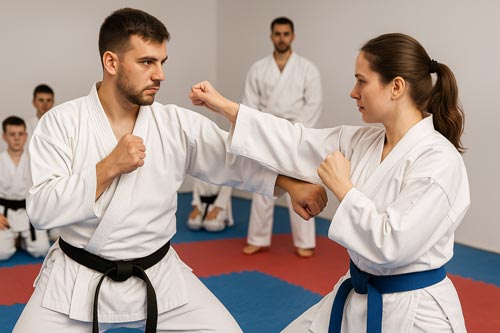
Partner drills are one of the most valuable parts of karate training, and they only work well when both students commit to practicing safely. This starts with clear communication. Before beginning a drill, partners often confirm the technique, the speed, and the level of contact expected. Even in a traditional dojo, where students train hard, safety is always part of the equation. When you let your partner know that you are ready and paying attention, you create an environment where both people can push themselves without risking unnecessary injuries.
Control is another key part of partner work. Techniques that look simple can feel very different when applied with too much force or poor timing. Beginners sometimes get excited and move faster than they should, while more experienced students learn how to adjust their intensity to match the person they are working with. This mutual control builds trust, and trust allows both students to practice more advanced techniques with confidence.
Good etiquette also means stopping immediately if something feels wrong. A missed block, a grip that slips, or a moment of imbalance can turn into a safety issue if a partner tries to force the technique instead of resetting. Most instructors encourage students to speak up if they need to slow down or clarify a movement. These small moments of communication show respect and help everyone train more effectively. When both partners focus on safety, the drills become smoother, more precise, and more enjoyable for everyone involved.
Keeping the Dojo Clean
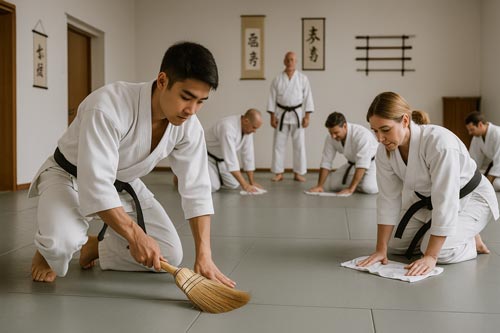
A clean dojo creates the foundation for safe and focused training. Even beginners notice how organized most dojos feel, and that atmosphere does not happen by accident. Students help maintain the space in small but meaningful ways. This includes wiping down equipment after use, straightening gear along the walls, and keeping personal belongings out of walkways. These habits keep the training area free of hazards and show respect for the place where everyone learns and improves.
Many dojos also have traditions connected to cleaning. Some classes end with students lining up to sweep the mats or wipe them with towels. This simple routine teaches responsibility and reinforces the idea that the dojo belongs to everyone, not just the instructor. Students learn that maintaining the space is part of their practice, and this creates a sense of ownership and pride in the environment where they train.
Cleanliness also helps prevent injuries. Dust, sweat, and debris can make mats slippery, so keeping the surface clear is essential for practicing kicks, stances, and takedowns safely. When students take a moment to check the mats before class or clean up after drills, the entire group benefits. These actions may seem small, but they reinforce the mindset that karate is about discipline in every part of training, not just the techniques themselves.
Final Thoughts on Karate Etiquette
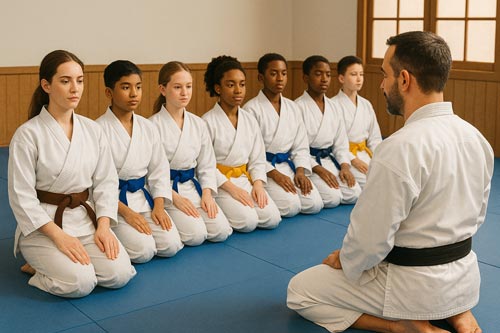
Once you spend some time in a dojo, you begin to realize that etiquette is not a list of rules you memorize. It is a mindset that makes training more meaningful for everyone. Bowing, staying focused, showing up prepared, caring for your uniform, and keeping the dojo clean all support the same idea. Every student, no matter their rank, helps create an environment where people feel safe, respected, and motivated to grow. These habits become part of your training just as much as blocking, striking, or practicing kata. When you follow them consistently, you get more out of every class and help strengthen the culture that makes karate such a powerful and rewarding art.
You May Also Be Interested In:
Leave a Reply
























